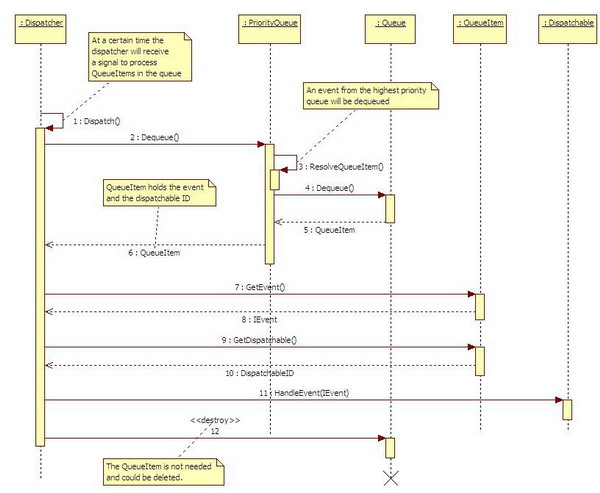Introduction
The Proactor Pattern is an asynchronous event handlingpattern. This pattern dispatches multiple events from multiple threads to the corresponding event handlers. This allows the application to have multiple operations running simultaneously without requiring the application to have a corresponding number of threads. Besides, it creates a "low coupling" and "high cohesion" between objects or a layered architecture.
Detailed information
Detailed information can be found in this book: Pattern-Oriented Software Architecture (Volume 2).
Background
Some time ago, I implemented the Proactor pattern inC++ (STL), and wondered if I could make thispattern in C# and .NET. Since the .NET framework already provides a set of functionality, it became less time consuming than expected.
Required skills
I'm sure (almost) every programmer could understand this pattern.
However, a set of programming and design skills are required which makes it easier to understand and to use this event handlingpattern. Here is the set of skills which makes it easier to understand:
You should know a bit about:
- Semaphores
- Singleton Pattern (see the GoF book)
- Locking shared data which can be accessed from multiple threads
- Bridge Pattern (GoF)
- Threads
- How to realize a "low coupling" and "high cohesion" relationship between objects
- UML
Don't get daunted by me. It's reasonable, I think...
When to use this pattern?
Use this pattern if:
- you like to have an asynchronous event handling
- your objects should independently transport events
- your events should be delivered with different priority levels
- you like to realize "low coupling" and "high cohesion" between layers or objects
UML class diagram
This is the class diagram of the Proactor pattern.
The idea of this example is to let the Bird fly (in software, of course). TheBird will receive a FlyEvent from another Bird and will call its "fly away" method.

Dispatcher: the dispatcher dispatches the received events to theDispatchables.Dispatchable: aDispatchableobject could receive events from the dispatcher.PriorityQueue: this queue contains the enqueued events (ordered in separate priority queues).Registry: contains the registeredDispatchableobjects.IDipatchable: the interface to theDispatchableobjects.Bird: theDispatchableobject which will receive asynchronous events from the dispatcher.
Sequence diagrams
Here are the sequence diagrams:
Registering

Enqueue event
Dispatch Event
Using the Proactor
Here is a set of instructions which must be done before using the Proactor Pattern.
- Every object which can receive an event must implement a
Dispatchableobject and inherit from theIDispatchable.public class Bird : IDispatchable { /// <summary> /// The dispatchable of the bird. /// </summary> private Dispatchable _dispatchable = new Dispatchable();
Why not inherit directly from the
Dispatchableobject?- Reason 1: this is high coupling and low cohesion, which we rather not want.
- Reason 2: data encapsulation.
- You should now implement the methods provided in the
IDispatchableinterface./// <summary> /// The handle event of the dispatchable /// </summary> /// <param name="ievent">the event to handle</param> public void HandleEvent(IEvent ievent) { Debug.Assert(ievent != null); if (ievent is FlyEvent) {
- Register the
IDispatchableat the dispatcher (theBirddoes this in its constructor)./// <summary> /// Constructor /// </summary> public Bird() { // this will register the Bird Dispatcher.GetInstance.Register(this); }
What does this Dispatcher do?
The heart of the Proactor Pattern is the
Dispatcher. ThisDispatcherdispatches the enqueued events to the registeredDispatchables in a (separate) thread./// <summary> /// Dispatches the events to the dispatchable items /// </summary> private void Dispatch() { // thread must be running. while (_dispachThread.ThreadState == System.Threading.ThreadState.Running) { // wait for signal _autoResetEvent.WaitOne(); // the queue should have at least one queue item available if( _queue.Count >= 1 ) {
The
Dispatcheris a Singleton./// <summary> /// This method will return the Dispatchers instance /// This is a Singleton pattern. /// </summary> public static Dispatcher GetInstance { get { lock (_instanceLock) { // if the instance exists, then return the // already created disptacher if (_instance == null) { // first time for the singleton _instance = new Dispatcher(); } return _instance; } } }
Keep in mind that events with a higher priority will be dispatched first. Be careful not to create starvation.
Example:
Time x: The
Dispatcher’s queue contains 210938 events with priority "Very High".Time x + 1 millisecond: A "Very Low" priority event has been enqueued (and no further events will be enqueued).
Time x + 32365 milliseconds: the
Dispatcher's queue still contains 21 events with a priority "Very High".The event enqueued at (Time + 1 ms) could be outdated. Don't get disappointed. There are mechanisms to prevent starvation, like a dynamic priority queue. The best part of having your own event handling mechanism is that such problems become suddenly...a challenge.
- Get the
Dispatcher's instance. - Create an event and enqueue it to the
Dispatcher. Decide the priority level of the event to enqueue.// event fired to the eagle FlyEvent fly = new FlyEvent(); Dispatcher.GetInstance.Enqueue(_eagle.DISPATCHABLE_ID, fly, Dispatcher.Priority.Normal );
Don't do
- Do not process too much in the
HandleEventof theDispatcher. - For the heroes, don’t be pessimistic prematurely.
To be continued
This Proactor Pattern could be extended with multiplepatterns. I’ll wait on the responses first before I make a "Part 2" of thisPattern.
License
This article, along with any associated source code and files, is licensed underThe GNU General Public License (GPLv3)





 本文介绍了一种异步事件处理模式——Proactor模式,该模式能够从多个线程调度事件到对应的事件处理器,允许应用程序同时运行多个操作而无需相应数量的线程。文中详细解释了Proactor模式的工作原理,并提供了实现该模式所需技能的概述。
本文介绍了一种异步事件处理模式——Proactor模式,该模式能够从多个线程调度事件到对应的事件处理器,允许应用程序同时运行多个操作而无需相应数量的线程。文中详细解释了Proactor模式的工作原理,并提供了实现该模式所需技能的概述。


















 309
309

 被折叠的 条评论
为什么被折叠?
被折叠的 条评论
为什么被折叠?








